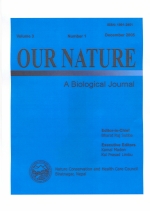Grazing Effects on Species Composition in Rangelands of Upper Mustang, Nepal
DOI:
https://doi.org/10.3126/on.v3i1.337Keywords:
Conservation, Grazed and ungrazed plots, Management, Rangeland, Species compositionAbstract
Conservation and management of rangelands require clear understanding of species composition. The objective of this paper is to show the differences in species composition, abundance, mean cover and height between the grazed and ungrazed plots in a specific pasture of Lo Manthang VDC in Upper Mustang. Two seasons' data were collected during July (wet season) and November (dry season) 2005. Species richness, Importance Value Index (IVI), cover and height of the species compared between grazed and ungrazed plots. Twenty species (17 belonging to 14 families: high-7, medium- 2, low – 6 and non palatable – 2 and 3 unidentified species) were recorded in the experimental plots. Species richness didn’t show any significant difference in between the ungrazed and grazed plots in both the seasons. On the basis of IVI value, Kobresia spp. a highly palatable species is dominant in the ungrazed plots in both the seasons. A significant difference (Chi2, p < 0.05, d.f. = 7) in cover during July indicates that the pasture has some impact of grazing.
Key words: Conservation, Grazed and ungrazed plots, Management, Rangeland, Species composition
doi:10.3126/on.v3i1.337
Our Nature (2005) 3: 69-76
Downloads
Downloads
How to Cite
Issue
Section
License
This license enables reusers to distribute, remix, adapt, and build upon the material in any medium or format for noncommercial purposes only, and only so long as attribution is given to the creator.




